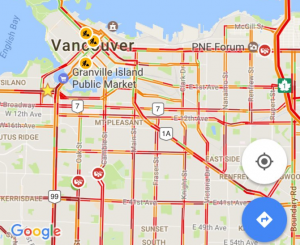
According to Business Insider, Vancouver was ranked 2nd worst traffic city in North America, followed by Los Angeles.
Vancouver
Congestion: 30% increase in driving time over no traffic
Morning peak: 51% increase
Evening peak: 65% increase
Los Angeles
Congestion: 33% increase in driving time over no traffic
Morning peak: 56% increase
Evening peak: 77% increase
Because Vancouver’s economy is growing, the demands on streets and sidewalks must also be increasing.
In May 2017, Vancouver became one of the first North American cities to adopt a traffic congestion plan to improve traffic flow, reduce gridlock, and keep people and goods moving efficiently across the city and region.
And the five goals supporting the new Congestion Strategy Management are:
1) Improve monitoring of traffic conditions and trends;
2) Improve road safety;
3) Ensure a smart and efficient transportation system;
4) Coordinate street use; and
5) Prioritize people and goods movement.
The Congestion Management Strategy is the latest of several initiatives Mayor Robertson and Council have adopted to improve transportation options and road conditions for all users, including:
* Moving toward Zero Traffic Fatalities
* Supporting the Mayors’ Council’s 10-Year Plan for Transit and Transportation
* A new, more efficient Parking Management System
* Transportation 2040 Plan to reduce emissions, improve health, and have a positive effect on the environment
* Launching Mobi, the City’s bike-share program last summer
UBC on its end is setting goals to be reached by 2040.
o TARGET 1: By 2040 at least two-thirds of all trips to and from UBC will be made by walking, cycling or transit and maintain at least 50% of all trips to and from the campus on public transit.
o TARGET 2: Reduce single occupant vehicle trips to and from UBC by 20% from 1997 levels and reduce single occupancy vehicle trips per person to and from UBC by 30% from 1997 levels.
o TARGET 3: Maintain daily private automobile traffic at or less than 1997 levels.
Among the goals set by UBC since 1997, some have been bringing good news, and some others the opposite.
According to the report released last year, in 2016 54% of all trips to UBC were made by sustainable travel modes and 52.5% of all trips to and from the campus were made by transit. Which is good news! Right?
If you look at the table below, we can see a tremendous increase in Transit. Since UBC has implemented a mandatory U-pass at $35 per month to students, which offers students unlimited access to TransLink Bus, SkyTrain and SeaBus services (all zones), and discounted West Coast Express fares it has seen success in reaching target 1.
However, numbers of carpool, bicycles and pedestrians are quite deceiving.
 Aside from implementing the mandatory U-Pass, UBC has changed the class start times in 2001 in order to spread the transit demand in the morning peak period. Before 2001, the first classes in the morning all began at 8:30 am. After the change, some classes started at 8:00 am, some at 8:30 or 9am.
Aside from implementing the mandatory U-Pass, UBC has changed the class start times in 2001 in order to spread the transit demand in the morning peak period. Before 2001, the first classes in the morning all began at 8:30 am. After the change, some classes started at 8:00 am, some at 8:30 or 9am.
Nevertheless, if we look at the graph below, the traffic peak is rather condensed at 10 am, instead of being evenly dispersed. Traffic peak at 10 am means that students starting class at 10 am will travel in between 9 to 9:30 am.
I personally think UBC should evenly spread the class starting hours from 8 to 10 am. I myself take the transit at 9am everyday, because all of my classes start at 10 am and I am having unpleasant experiences every morning commuting to UBC.
Sometimes, buses would be full and would just pass without embarking people waiting at stops and most of the time, I would travel to UBC standing up in a crowded bus (which is a good 45 standing with heavy backpack).
Think about it. If traveling by bus is such a hassle, those who have the option to drive their own car will rather choose to drive.
The third column of table 2.1 shows that the majority of students travel either with Public Transit (73,300)or Single Occupant Vehicle (SOV) (51,300).
I mean, if UBC wants to reduce the number of SOV, then one of the change it should undertake is evenly spreading the class start hours to reduce the traffic peak at 10 am.
